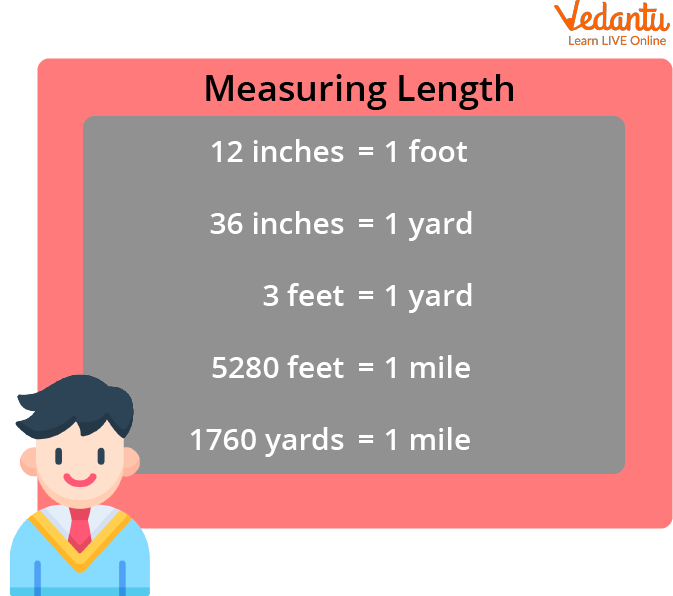




Introduction to Measuring Length
In the conversion of measuring length, we will figure out how to change metres into centimetres, kilometres into metres, and centimetres into endless metres into kilometres.
As we know the standard unit of length is a metre. Smaller lengths are measured in centimetres which are composed of centimetres. The kilometre is the greater unit of length.
1 metre = 100 centimetres
1 kilometre = 1000 metres

Measuring Length
Thus, to change a metre into centimetres, we multiply by 100, and for centimetres into metres, we divide by 100. To change kilometres into metres, we multiply by 1000, and for metres into kilometres, we divide by 1000.
Measurements Conversion
To change metres into centimetres, multiply the number of metres by 100.
1 metre = 100 centimetres
2 metre = 2 × 100 centimetres = 200 centimetres
3 metre = 3 × 100 centimetres = 300 centimetres
5 metre = 5 × 100 centimetres = 500 centimetres
To convert kilometres into metres, multiply the number of kilometres by 1000.
1 kilometres = 1000 m
2 kilometres = 2 × 1000 m = 2000 metres
3 kilometres = 3 × 1000 m = 3000 metres
7 kilometres = 7 × 1000 m = 7000 metres
To convert into metres, divide the number of centimetres by 100 or put a dot (.) after 2 digits from right.
100 centimetres = 1.00 metres or 1 metres
200 centimetres = 2.00 metres or 2 metres
800 centimetres = 8.00 metres or 8 metres
1100 centimetres = 11.00 metres or 11 metres
100 centimetres = 100 ÷ 100 = 1 metre
200 centimetres = 200 ÷ 100 = 2 metres
800 centimetres = 800 ÷ 100 = 8 metres
1100 centimetres = 1100 ÷ 100 = 11 metres
To convert metres into kilometres, divide the number of metres by 1000 or put a dot (.) after 3 digits from right.
1000 metres = 1000 ÷ 100 = 1 kilometres or 1.000 kilometres
2000 metres = 2000 ÷ 100 = 2 kilometres or 2.000 kilometres
3000 metres = 3000 ÷ 100 = 3 kilometres or 3.000 kilometres
9000 metres = 9000 ÷ 100 = 9 kilometres or 9.000 kilometres
To convert miles and kilometres:
Km to Mile
1 km = 0.621 mile
Mile to Km
1 mile = 1.609 km
Tools to Measure Length
There are various tools for the measurement of the length of various things. The list of most commonly used tools for measuring length is given below:
Tapes
Measuring sticks
Metre sticks
Feet/foot scale
Some Important Measurement Conversions
Length
1 mile = 1760 yards
1 yard = 3 feet
1 foot = 12 inches
Mass
1 ton = 2000 pounds
1 pound = 16 ounces
Volume
1 gallon = 4 quarts
1 quart = 32 liquid ounces
Currency
1 dollar = 100 cents
Time
1 day = 24 hours
1 hour = 60 minutes
1 minute = 60 seconds
Solved Examples
Example 1. 5 metre = ____ decimetre
Ans: 1 metre = 10 decimetre
5 metre = 5 × 10 = 50 decimetre
Example 2. 45 decimetre = ___ m
Ans: 1 decimetre = 0.1 m
45 decimetre = 45 × 0.1
= 4.5 m
Example 3. 10 m = _____cm
Ans: 1 metre = 100 centimetre
10 metre = 10 × 100
= 1000 cm
Example 4. 500 cm = ______ m
Ans: 1 centimetre = 0.01 metre
500 cm = 500 × 0.01
= 5 m
Example 5. 16 m = _____mm
Ans: 1 metre = 1000 millimetre
16 metre = 16 × 1000
= 16000 mm
Example 6. 68 millimetre = _____m
Ans: 1 millimetre = 0.001 metre
68 millimetre = 68 × 0.001
= 0.068 m
Practice Problems
1. 20 m = _____decametre ?
Ans: 2 decametre
2. 35 decametre = ___ metre ?
Ans: 250 metres
3. 35 m = _____hectometre ?
Ans: 0.35 hectometre
4. 1 hectometre = ___ metre ?
Ans: 100 metres
5. 50 m = _____kilometre ?
Ans: 0.05 kilometre
6. 500 kilometre = ____m ?
Ans: 500000m metre
Conclusion
The fundamental rule of conversion is that if you want to convert from a larger unit to a smaller unit, then multiply. If you want to convert from a smaller unit to a larger unit, then divide. Knowing the various units used in the metric system is significant; the purpose behind learning the metric system for measuring is for you to have the option to use these measurement units to calculate the size, mass, or volume of various articles.
FAQs on Length Conversion
1. What is measuring length?
Measuring length is defined as recognizing how long is the given item. Length is a quantifiable quality provided to objects to identify them and work with them effectively. In laboratories, while taking scientific measurements, it is essential to be both accurate and exact. Accuracy represents how close a measurement comes to its actual value. This is significant because bad equipment, poor data, or human mistake can lead to inaccurate results that are not close to the true value. Vernier calliper is used for taking small length measurements.
2. What is the purpose of conversion?
A unit conversion expresses a similar property as a different unit of measurement. For example, time can be expressed in minutes rather than hours, while distance can be converted from miles to kilometres or metres, or feet, or some other measure of length. Frequently, measurements are given in one set of units, like feet, but are required in various units, like chains. A conversion factor is a numeric expression that enables feet to be changed to chains as an equivalent value.
3. Why do we need to measure length?
Measurement is needed because it is required to find out the accurate length, area, volume, or mass of different objects for various purposes. We need to measure length and distance to calculate the accuracy and reliability of the object.











